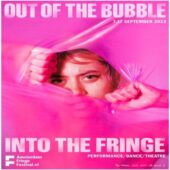Brighton Year-Round 2019
Julia Wallin Piano Recital
Julia Wallin

Genre: Live Music, Music
Venue: All Saints, Hove
Festival: Brighton Year-Round
Low Down
Julia Wallin gave a piano recital of Erkki Melartin, Toivo Kuula, Rachmaninov and Sibelius.
Review
Julia Wallin’s return to All Saints, Hove has been eagerly anticipated, not least because of the programme: nearly all this music is from her native Finland, and mostly unknown to the UK concert-goer.
Wallin made a deep impression in her previous concert, particularly when it came to Finnish items. Here she started with one of the better-known Finnish composers, Erkki Melartin who lived from 1875-1937. To give a context those were Ravel’s dates too. Melartin, absorbing French impressionism as well as Sibelius’ opening-up of a Finnish musical language, wrote or sketched nine symphonies, a violin concerto, symphonic poems and much chamber music.
The three piano pieces started with ‘Rain’, a Debussyian study with structure and a sense of shimmering development. It’s a highly attractive piece. The Barcarolle which followed has a lyrical core trammelled by the barcarolle rhythms. So there’s sea-changes from travelling on water to evoke a passage transcending any such notion, in the way Fauré developed the form. It’s a more passionate piece, and this gave on to the surprise of ‘Salomé’s Dance’. This piece begins like a flirtation in an Art Nouveau salon. It ends with a hammering passionate declamation of memorable power. There’s nothing of Salomé in it unless it portrays someone hopelessly caught in a political and sexually abusive vice.
Wallin’s tonal palate is one that gravitates to anything layered: by turns an astringent and sumptuous late romanticism. She’s a born colourist too. Such choices also release an adventuring into neglected repertoire: nothing’s obvious. Except that Finland produces more musicians and rally-drivers per capita than can be conceived. It’s time we heard far more Finnish music. Alongside the UK, they’ve produced more gifted composers in the last 50 and more years than just about anywhere else.
Toivo Kuula 1883-1918) Sibelius’ nly pupil, is a national icon. Shot in a perhaps friendly-fire incident in a drunken bar when the Bolshevik Reds and nationalist liberal Whites were fighting, he’s the greatest loss to Finnish music unless it be the tubercular Eduard Milck (1877-99) who died before he was 22, after challenging Sibelius with his one symphony.
Kula’s remembered for a few orchestral and vocal pieces, mainly songs; and might have gone on to write operas. His ‘Nocturno’ is a memorable varied night-piece. It’s thewed with incident and power, palimpsests of melodic fragments and sudden long-breathed resolves.
As is ‘Mutton dance’ which is a revelation, and Wallin makes much of its sequential differences. It might have ancient folk roots. Its theme sounds so strikingly like the Spanish La Folia from the 15th century, that you wonder if they’re from the same root. Rachmaninov whom we heard next assumed La Folia was actually by Corelli, the earliest of the baroque composers who set variations to it. Rachmaninov’s Variations on a Theme of Corelli is breathtakingly close in tone, melody and design to this set of variations too. The difference is that Rachmaninov’s piece dates from 1932, and this is 20 years older. It’s a stunning set, more impressionist but also striking through romantic gestures with a shimmering subtlety Kuula might have made commandingly his own. ‘Mutton Dance’ must approach the zenith of misleading titles.
Rachmaninov’s Moment Musicaux Op 16 from 1896 are earlier than his sets of Preludes and more inward, still emerging in long-held cantilena lines, brooding or shimmering with the excitement of a voice already strong discovering something different. In fact the failure of his Symphony No. 1 with its thrilling power and barbaric blaze provoked a crisis that meant when it was resolved Rachmaninov cleaved to a resolutely tonal conservatism.
Here Wallin revelled in the tonal ambiguities and then sudden melodic resolutions, playing Nos. 2 and 4 from the set. She clearly displays an affinity for this side of Rachmaninov, one of half-lights and veiled declaration.
Sibelius is a fitting conclusion, a journey back to the source. His Trees Op 75 from 1913 are five short pastel versions of Sibelius’ natural thew and snap. They’re increasingly more characterful, with the fourth and fifth quite striking too; though Sibelius only intermittently realized his imaginative powers on the piano.Finally Wallin essayed the piano version of Sibelius’ nationalist signature work, Finlandia Op 26, from 1899, revised in 1900. This stirring wonderfully memorable paean to cultural and national identity must be the most affirmative of its kind, and certainly the most popular of all such works.
The piano version emphasizes the sudden pauses and a sudden rush hammered in anything from glissandi and tremolo effects. A final striking out for the home key in Wallin’s hands are both stirring and tumultuous. This is what Wallin revels in, and she must return to play more Finnish music.

































